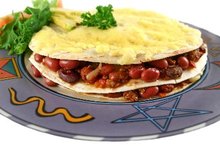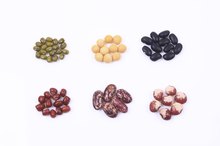Can Diabetics Eat Rye Bread & Pumpernickel Bread?
Diabetics can eat the same foods as anyone else; they just need to watch their portion sizes to keep their carbohydrate intake at the recommended levels, which are usually 45 to 60 grams per meal. When choosing your bread, the American Diabetes Association recommends opting for those brands that have a whole grain listed as the first ingredient, such as whole-grain rye, rather than a refined grain.
Comparing Carbohydrates
A regular slice of rye bread has about 83 calories and 15.5 grams of carbohydrates, including 1.9 grams of fiber. If you eat pumpernickel bread, with each slice you'll consume 65 calories and 12.4 grams of carbohydrates, including 1.7 grams of fiber. Either of these breads can fit into a diabetes diet, with each slice counting as one serving of carbohydrates out of the three to four 15-gram servings typically allowed per meal. Pumpernickel bread, however, is slightly lower in carbohydrates and calories, so it is a better choice for diabetics.
- A regular slice of rye bread has about 83 calories and 15.5 grams of carbohydrates, including 1.9 grams of fiber.
- If you eat pumpernickel bread, with each slice you'll consume 65 calories and 12.4 grams of carbohydrates, including 1.7 grams of fiber.
Related Articles
References
- Health-Alicious-Ness.com: Nutrition Facts Comparison Tool
- American Diabetes Association: Diabetes Myths
- Bread, pumpernickel. FoodData Central. U.S. Department of Agriculture. Published April 1, 2020.
- Rye kernel (Pumpernickel) bread. University of Sydney GI Database. Updated November 26, 2019.
- National Institutes of Health Office of Dietary Supplements. Manganese: Fact sheet for consumers. Updated October 8, 2019.
- National Institutes of Health Office of Dietary Supplements. Selenium: Fact sheet for consumers. Updated December 10, 2019.
- National Center for Complimentary and Integrative Health. Antioxidants: In depth. Updated November 2013.
- Adlercreutz H. Can rye intake decrease risk of human breast cancer?. Food Nutr Res. 2010;54:10.3402/fnr.v54i0.5231. doi:10.3402/fnr.v54i0.5231
- Jonnalagadda SS, Harnack L, Liu RH, et al. Putting the whole grain puzzle together: health benefits associated with whole grains--summary of American Society for Nutrition 2010 Satellite Symposium. J Nutr. 2011;141(5):1011S‐22S. doi:10.3945/jn.110.132944
- Holma R, Hongisto SM, Saxelin M, Korpela R. Constipation is relieved more by rye bread than wheat bread or laxatives without increased adverse gastrointestinal effects. J Nutr. 2010;140(3):534-41. doi:10.3945/jn.109.118570
- Bread, white. FoodData Central. U.S. Department of Agriculture. Published April 1, 2020.
- Miketinas DC, Bray GA, Beyl RA, Ryan DH, Sacks FM, Champagne CM. Fiber intake predicts weight loss and dietary adherence in adults consuming calorie-restricted diets: The POUNDS lost (preventing overweight using novel dietary strategies) study. J Nutr. 2019;149(10):1742‐1748. doi:10.1093/jn/nxz117
- Jenkins DJ, Wolever TM, Jenkins AL, et al. Low glycemic response to traditionally processed wheat and rye products: bulgur and pumpernickel bread. Am J Clin Nutr. 1986;43(4):516-20. doi:10.1093/ajcn/43.4.516
- Breen C, Ryan M, Gibney MJ, Corrigan M, O'shea D. Glycemic, insulinemic, and appetite responses of patients with type 2 diabetes to commonly consumed breads. Diabetes Educ. 2013;39(3):376-86. doi:10.1177/0145721713479675
- Letrán A, Palacín A, Barranco P, Salcedo G, Pascual C, Quirce S. Rye flour allergens: an emerging role in baker's asthma. Am J Ind Med. 2008;51(5):324-8. doi:10.1002/ajim.20566
- American Academy of Allergy, Asthma, and Immunology. Celiac disease, non-celiac gluten sensitivity, and food allergy: how are they different?.
- American Academy of Allergy, Asthma, and Immunology. Gluten intolerance definition.
Writer Bio
Based in Massachusetts, Jessica Bruso has been writing since 2008. She holds a master of science degree in food policy and applied nutrition and a bachelor of arts degree in international relations, both from Tufts University.









